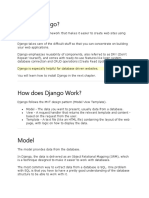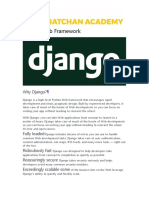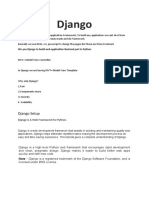0% found this document useful (0 votes)
35 views7 pagesDjango Basics: Setup, Architecture, MVT
Uploaded by
trw.dcnCopyright
© © All Rights Reserved
We take content rights seriously. If you suspect this is your content, claim it here.
Available Formats
Download as PPTX, PDF, TXT or read online on Scribd
0% found this document useful (0 votes)
35 views7 pagesDjango Basics: Setup, Architecture, MVT
Uploaded by
trw.dcnCopyright
© © All Rights Reserved
We take content rights seriously. If you suspect this is your content, claim it here.
Available Formats
Download as PPTX, PDF, TXT or read online on Scribd
/ 7







































































